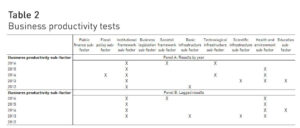
Business Efficiency and Productivity
The actions and policies of the government and their outcomes (e.g., infrastructure indicators) affect the efficiency and productivity of the private sector. In this Criterion of the Month, we assess some of the key indicators driving business efficiency and productivity.
We use stepwise regressions to carry out two sets of tests to identify the competitiveness sub-factors that influence business efficiency and productivity. The first set of tests take the efficiency of business factor as the outcome and all sub-factors related to the government efficiency and infrastructure factors as the input. We ran these tests by year starting in 2012 up to 2016. That is to say, we take business efficiency 2014 as the outcome of all 2014 relevant sub-factors. The effect of our assumed inputs (e.g., policies), however, may be fully realized sometime after their implementation. For this reason, we lag the input indicators by one year in the second phase of the tests. For the 2016 business efficiency factor, for example, we take all input sub-factors from the previous year (i.e., 2015). The second set of tests, triangulates the results by substituting the business efficiency factor by the business productivity sub-factor and carry on the same two-steps (i.e., by year and one year lagged) analysis.
Results from the first round of tests show that there is a set of sub-factors that throughout the period of study are statistically significant in their impact on business efficiency. These key drivers (or inputs) are fiscal policy, institutional framework, societal framework and education.
Lagging the year of inputs leads to similar results with the exception that education becomes less significant (see Table 1).

In the second round of tests, which focus on business productivity, we find that the only sub-factor that is consistently significant throughout the 2012-2016 period is the institutional framework sub-factor. Lagging the input sub-factors for business productivity, only the institutional framework and the health and environment sub-factor are significant statistically throughout (see Table 2). These results indicate that “institutional competitiveness” plays an essential role in defining the efficiency and productivity of business.
What does institutional competitiveness mean? A peruse of the institutional framework components highlights the fundamental role of stability and predictability in this context. We thus propose that the quality of the legal and regulatory system is a key driver of efficiency and productivity. Similarly, the level of the government policies’ adaptability to changes in the economy is essential. We also propose that increasing the transparency of government policy-making and simultaneously limiting bribery and corruption drive business efficiency and productivity. We thus expect the Rule of Law and the country credit rating indicator, which evaluates the political, economic and financial risks that underline a particular country’s credit quality, to be of high significance.
The above propositions may seem self-evident to some observers but current political trends suggests that in some countries institutional competitiveness is somewhat in decline. It is thus necessary to revisit its fundamental role. We will tests the above propositions in a future Criterion of the Month.
Research Information & Knowledge Hub for additional information on IMD publications
- Business efficiency and productivity (Part I)
- Business efficiency and productivity (Part II)
- Business efficiency and productivity (Part I)
- Business efficiency and productivity (Part II)
Research Information & Knowledge Hub for additional information on IMD publications
Research Information & Knowledge Hub for additional information on IMD publications
Assortment optimization presents a complex challenge for retailers, as it depends on numerous decision factors. Changes in assortment can result in demand redistribution with multi-layered consequences. This complexity is even more pronounced for ...
A "radar chart" is proposed to visualize where the company needs to improve. It can also be used to support the discussion of any group of executives on the reasons for failure of most strategic initiatives; they may do that by assessing their own...
To understand America’s aggressive shift on trade, you must first grasp the silent, slow building, decades-long erosion of American middle-class prosperity. This shift began well before President Trump and will outlive him. It is rooted in the col...
Donald Trump has been called many things but his newest label – the great unifier of Europe – might just stick. That provocative notion may raise eyebrows in Brussels, Paris, or Berlin, but Mr Trump’s return could be the shock that finally compels...
in European Journal of Operational Research August 2025, vol. 324, no. 3, pp. 799-813, https://doi.org/10.1016/j.ejor.2025.01.035
Research Information & Knowledge Hub for additional information on IMD publications
Research Information & Knowledge Hub for additional information on IMD publications
Research Information & Knowledge Hub for additional information on IMD publications
Research Information & Knowledge Hub for additional information on IMD publications
Research Information & Knowledge Hub for additional information on IMD publications
Research Information & Knowledge Hub for additional information on IMD publications
Research Information & Knowledge Hub for additional information on IMD publications
in Gensler, Gary (Ed.); Johnson, Simon (Ed.); Panizza Ugo (Ed.); Weder di Mauro, Beatrice (Ed.) / The Economic Consequences of The Second Trump Administration: A Preliminary Assessment, pp. 239-244 / PAris: CEPR Press, 2025
Research Information & Knowledge Hub for additional information on IMD publications
Published by International Institute for Management Development ©2025
Research Information & Knowledge Hub for additional information on IMD publications
Research Information & Knowledge Hub for additional information on IMD publications









